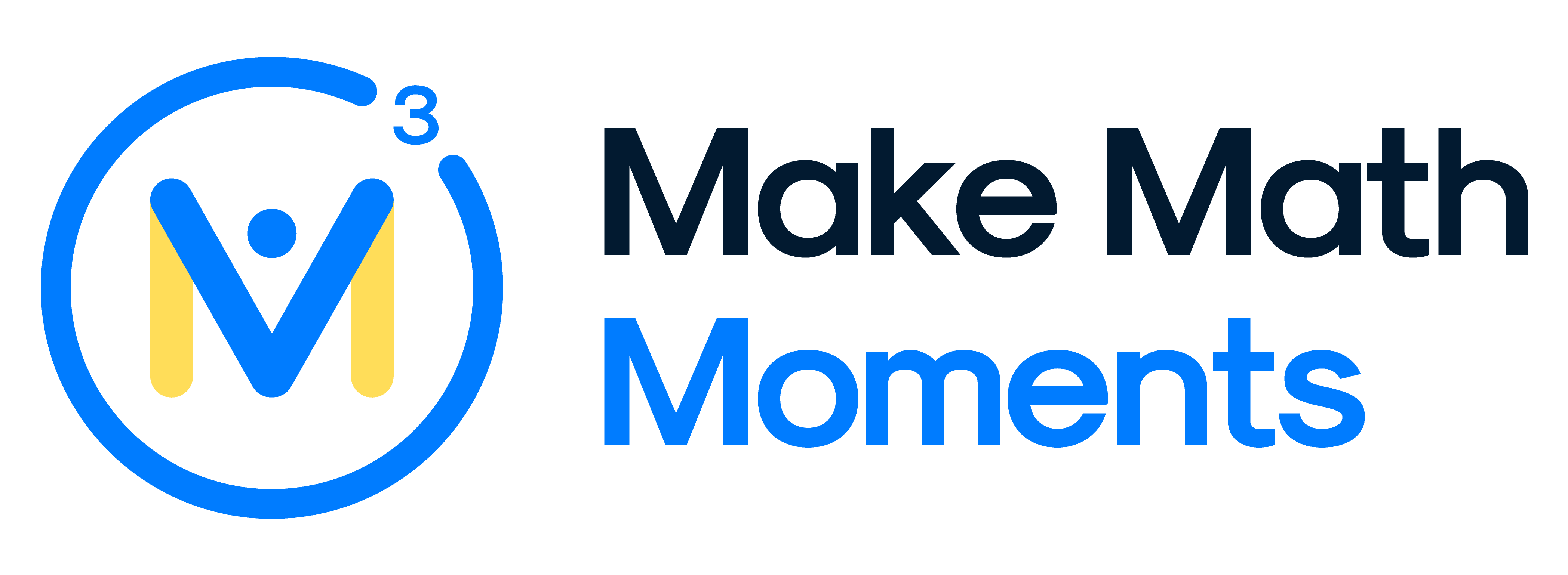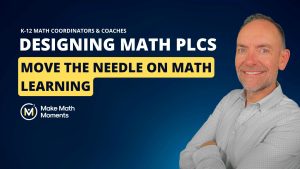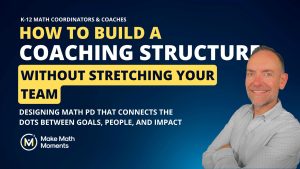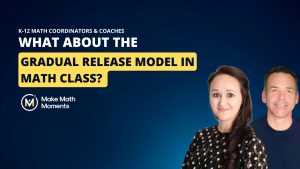If you’ve ever led math improvement work, you know how easy it is to lose momentum.
A new initiative launches, energy is high, and for a while, it feels like things are moving.
But then—turnover happens. Priorities shift. The focus blurs.
That’s why, at Make Math Moments, we talk about building a math improvement flywheel—a system designed to keep progress moving even when the players change.
It’s a process for turning disconnected efforts into sustainable growth across classrooms, schools, and districts.
And at the heart of that math improvement flywheel lies one question that every leader eventually faces:
“What do we want math learning to look and feel like for students in our system?”
Before you can write a compelling vision or align professional learning, you need a shared language—one that’s grounded in research and clear enough that everyone in your system can recognize it when they see it.
Let’s look at two stories, one around shared mathematical experiences and one around shared mathematical meanings.
Shared Mathematical Experiences: The Heart of Meaningful Shifts
Krista, a middle school principal, had been leading her building through a season of change—new curriculum, new assessments, new district goals. Like many leaders, she was balancing optimism with exhaustion.
Her math department had been working hard, but it was two classroom teachers who quietly sparked something remarkable. They shifted their approach to assessment—replacing unit tests with reasoning tasks and focusing feedback on how students were thinking, not just whether their answers were correct.
By midyear, something extraordinary happened:
- Ninety percent of their students met or exceeded benchmark expectations.
- Homework completion rose.
- Discipline referrals dropped.
Students weren’t just learning more math—they were experiencing math differently.
Naturally, Krista wanted to scale it. She invited other teachers to observe, shared the data, and presented the approach at a staff meeting.
Instead of excitement, she got silence—and pushback.
“We’re already trying new routines from PD.”
“Why change now? The district’s adopting a new curriculum next year.”
“Our kids aren’t ready for that kind of work.”
Krista realized she’d been leading with teacher moves—strategies, routines, and protocols. To her staff, it sounded like one more thing to add to an already full plate.
So she changed her approach.
Instead of asking teachers to copy what the others were doing, she invited them to imagine what it felt like to be a student in those classrooms. She shared photos, videos, and student quotes:
“This is the first time I know what I’m supposed to be thinking about, not just what answer to get.”
“I used to hate math because I always felt behind. Now I feel like I’m part of it.”
Then she asked one simple question:
“How can we make sure every student in this school gets to feel this way about math?”
That moment shifted everything. Teachers stopped talking about PD requirements and started talking about student experiences.
They weren’t “implementing a strategy” anymore—they were chasing a feeling.
The Lesson: Start with the Student Math Experience
Krista’s story reveals a universal truth:
You can’t create lasting instructional change by starting with what teachers should do.
You have to start with what students should experience.
When we frame math improvement around strategies, we get compliance.
When we frame it around students’ mathematical lives, we build belief—and that belief becomes the engine of sustainable change.
Now let’s look at a story about creating coherence.
Shared Mathematical Meaning: Creating Coherence in Mathematics
We see this in districts everywhere. Leaders and teachers often agree on goals like helping students “reason mathematically” or “build fluency.”
But ask what those actually look like in a classroom, and you’ll get a dozen different answers.
That lack of shared meaning—coherence—is one of the biggest barriers to improvement.
One district we worked with had chosen “fluency” as their improvement goal. Their plan seemed airtight: every teacher would implement fluency routines three times a week.
But when the leadership team was asked, “What does fluency mean to you?”—each person answered differently.
For one, it meant speed and accuracy.
For another, flexibility in strategy use.
For another, deep conceptual connections.
They had alignment on paper, but not in practice.
Once the team took time to define what fluency looked and felt like for students—how it sounded, what it meant to be fluent—their professional learning came alive again.
They stopped tracking whether teachers were “doing the routines” and started noticing whether students were reasoning flexibly, efficiently, and accurately.
That shift—from compliance to coherence—reignited belief and brought purpose back into their work.
Building Shared Meaning: The Next Step for Math Leaders
If you’re a district or school leader, your next move is twofold:
- Understand what quality mathematical experiences for students should look like.
What are students doing, saying, and thinking in a thriving math classroom? - Build coherence around those experiences.
Use your state, province, or national process standards—whether that’s the Common Core Standards for Mathematical Practice, Ontario’s Process Expectations—to create a shared language that everyone can recognize and apply. If you are truly going to create meaningful shifts in schools are you sure when you say “fluency” everyone else sees the same classroom experience as you do?
Because clarity without coherence is fragile.
And coherence without clarity is aimless.
When both come together—when everyone in your system can articulate why math matters and what it looks like when it’s thriving—you’ve taken a powerful step toward lasting improvement.
If You’re a Math Leader…
If your district’s math work feels scattered, or you’re struggling to see consistent impact, start where this team did:
- Define one shared vision for math instruction.
- Identify a small set of measurable key results.
- Build a professional learning system that keeps the focus alive all year.
You don’t have to do it alone — that’s exactly what the Make Math Moments District Improvement Program is designed to support.
Learn more about building a sustainable math improvement plan






